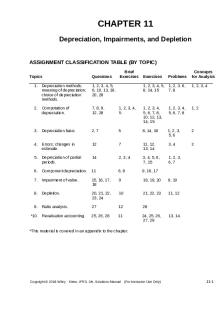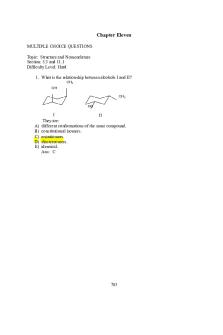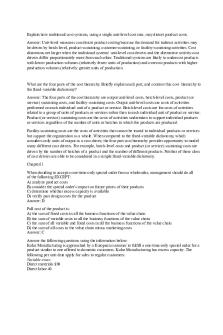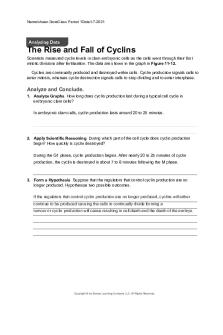Buckwold 21e Solutions Ch11 PDF

| Title | Buckwold 21e Solutions Ch11 |
|---|---|
| Author | michael lam |
| Course | Advanced Tax |
| Institution | The University of Western Ontario |
| Pages | 75 |
| File Size | 1.1 MB |
| File Type | |
| Total Downloads | 21 |
| Total Views | 151 |
Summary
Answer Key...
Description
Buckwold and Kitunen, Canadian Income Taxation, 2018-2019 Ed.
CHAPTER 11
CORPORATIONS―AN INTRODUCTION
Review Questions
1.
“A corporation is an artificial person separate and distinct from its owners.” Briefly explain this statement.
2.
Identify the types of relationships that can exist between a corporation and its shareholders.
3.
What factors may influence the value of a corporation’s common share capital?
4.
Identify two ways in which a shareholder can realize a return on a share investment. Describe the relationship between them.
5.
“Given the choice, individual shareholders of a corporation prefer to receive their return on investment by way of dividends, rather than from the sale of shares at a profit.” Is this statement true? Explain.
6.
“A shareholder may have a primary relationship as well as secondary relationships with the corporation. The difference between the (two relationships relates to the tax treatment of income flows between the corporation and the shareholder.” Explain.
7.
Corporations and individuals determine their taxable income in different ways. What are the differences?
Copyright © 2019 McGraw-Hill Education Ltd. Instructor Solutions Manual Chapter Eleven
1
Buckwold and Kitunen, Canadian Income Taxation, 2018-2019 Ed.
8.
How are the net capital losses and non-capital losses of a corporation affected when voting control of the corporation shifts from one shareholder to another?
9.
If the shares of a corporation that has non-capital losses are about to be sold and if those losses arise from business operations, why is it important for the vendor to consider the nature of the purchaser?
10.
An existing corporation that operates a profitable retail business is considering expanding its activities to include manufacturing. The expansion business can be organized in either of two basic ways. Describe them. Also, what factors must be considered when a choice is being made between the two structures?
11.
How does the tax treatment of intercorporate dividends affect the relationship between dividends and capital gains when one corporation invests in shares of another corporation? (Assume that both entities are taxable Canadian corporations.)
12.
Explain why the federal tax reduction of 13% or a provincial tax reduction on manufacturing and processing activities may apply to an amount that is greater than or less than the corporation’s actual income from manufacturing. Is it possible for a corporation that earns $500,000 from retail activities and suffers a loss of $50,000 from manufacturing activities to be eligible for the 13% manufacturing reduction?
Copyright © 2019 McGraw-Hill Education Ltd. Instructor Solutions Manual Chapter Eleven
2
Buckwold and Kitunen, Canadian Income Taxation, 2018-2019 Ed.
13.
What is the marginal tax rate for a public corporation in Ontario on income derived from a chain of restaurants? Show calculations.
14.
Because income earned by a corporation is first subject to corporate tax and then taxed a second time when after-tax profits are distributed to individual shareholders, shareholders are entitled to claim a dividend tax credit. Does the dividend tax credit eliminate the double taxation of corporate profits? Explain.
15.
The following statement appeared in the media: “There are 60,000 Canadian corporations that earned a profit for the year but incurred no income tax liability.” Is it possible that this statement is true? If it is, explain the principal reasons why, and state your opinion as to whether changes to the tax system are warranted.
Copyright © 2019 McGraw-Hill Education Ltd. Instructor Solutions Manual Chapter Eleven
3
Buckwold and Kitunen, Canadian Income Taxation, 2018-2019 Ed.
Solutions to Review Questions
R11-1.
By law, a corporation is recognized as an entity which has the power to act on its own behalf and enter into enforceable legal agreements. It can own property, sell and lease property, and borrow funds in the same way that an individual can. Although the corporation is owned by its shareholders, the affairs of the corporation are separate from the affairs of its owners. Therefore, property owned by the corporation is not property owned by the shareholder, and debts of the corporation are not debts of the shareholders. As a separate entity, the corporation is subject to income tax on its profits. However, when those after-tax profits are distributed to the shareholders they are again included in the shareholders income for tax purposes [ITA 12(1)(j)].
R11-2.
A shareholder can have both a primary and a secondary relationship with the corporation. Under a primary relationship, the shareholder provides equity capital to the corporation in exchange for shares. The shareholder can receive a return from the shares in the form of dividend distributions and/or share value enhancement. Under a secondary relationship, the shareholders may also act as a creditor, supplier, customer, employee, or lessor to the corporation. They can, therefore, loan money to the company in exchange for interest, lease property to the company in exchange for rent, provide services in exchange for salary and so on.
R11-3.
The following factors may influence the value of a corporation's common share capital.
R11-4.
Profits earned or losses incurred by the corporation. Profits retained belong to the common shareholders and the share value increases accordingly.
Dividends paid by the corporation. Dividend distributions reduce the equity of the corporation and the share value declines accordingly.
Increases or decreases in the value of assets owned by the corporation, including tangible assets such as land and buildings, and intangible assets such as goodwill.
A shareholder who provides share capital to a corporation can realize a return on investment from dividends or from capital gains when shares that have increased in value are sold. The two are related because dividend payments alter the value of the shares, thereby affecting the potential capital gain (loss) on sale. If after-tax corporate profits are retained by the corporation, the value of the shares increases, which may create a capital gain if the shareholder sells the shares. On the other hand, if corporate earnings are
Copyright © 2019 McGraw-Hill Education Ltd. Instructor Solutions Manual Chapter Eleven
4
Buckwold and Kitunen, Canadian Income Taxation, 2018-2019 Ed.
distributed as a dividend, the value of the shares declines and reduces the amount of capital gain that would otherwise occur when the shares are sold.
R11-5.
It is not always true that a shareholder prefers a dividend over a capital gain. First of all, the shareholder may be entitled to the capital gains deduction on shares of a qualified small business corporation (QSBC), in which case a capital gain is preferable to a dividend. Both dividends and capital gains have preferential treatment (dividends - the dividend tax credit, capital gains – 1/2 taxable). The tax rate on non-eligible dividends is higher than the rate on capital gains, except in the lowest tax bracket where the opposite is usually true. The tax rate on eligible dividends is normally lower than the rate on capital gains in first two tax brackets. However, the opposite usually occurs in the top tax bracket. See Exhibit 10-8 for the actual marginal tax rates for the top income tax bracket by source for each province. Using the marginal rates developed in Chapter 10 (Exhibit 10-7) for a particular province, the rates can be compared as follows:
Copyright © 2019 McGraw-Hill Education Ltd. Instructor Solutions Manual Chapter Eleven
5
Buckwold and Kitunen, Canadian Income Taxation, 2018-2019 Ed.
Capital Gains
Eligible
Non-eligible
Dividends
Dividends
Low bracket
12%
0%
13%
2nd bracket
16%
10%
22%
3rd bracket
20%
21%
31%
4th bracket
23%
28%
37%
High bracket
25%
35%
43%
Keep in mind that the timing of the tax may be different for each option. Capital gains are taxed only when the property is sold whereas dividends are taxed when received.
R11-6.
In the primary relationship, dividends paid by the corporation are not deductible by the corporation when determining its income for tax purposes, but the receipt of the dividends is taxable to the shareholder. Therefore, corporate income distributed to shareholders as dividends are subject to two levels of tax. In secondary relationships, payments to the shareholder for salary, interest, and rents are all deductible for tax purposes by the corporation and fully taxable to the recipient. Because such payments reduce corporate income before tax it effectively shifts corporate income from the corporation to the shareholder with the result being that there is only one level of tax.
R11-7.
The conversion of net income for tax purposes to taxable income for corporations is different because it includes several special reductions that are not permitted for individuals. In arriving at taxable income a corporation, in addition to deducting net capital losses and non-capital losses, can also deduct:
dividends from taxable Canadian corporations included in net income [ITA 112(1)],
dividends from foreign affiliate corporations included in net income [ITA 113], and
charitable donations [ITA 110.1(1)].
A further difference is that a corporation is not entitled to the capital gains deduction which exempts $848,252 (in 2018) of gain on certain qualified properties. Copyright © 2019 McGraw-Hill Education Ltd. Instructor Solutions Manual Chapter Eleven
6
Buckwold and Kitunen, Canadian Income Taxation, 2018-2019 Ed.
R11-8.
If voting control of a corporation shifts from one shareholder or group of shareholders to another, any net capital and non-capital losses are affected as follows:
Net capital losses are deemed to expire [ITA 111(4)(a)].
Non-capital losses that were incurred from a business operation continue to be carried forward, but can only be offset against profits earned by the business that incurred the loss or a similar business. In addition, the loss business must be carried on at a profit or with a reasonable expectation of profit throughout the taxation year in which the losses carried forward are deducted. If the loss business is terminated before the losses are used, the loss carry-overs will not be available [ITA 111(5)].
Non-capital losses that were incurred from ABILs and property losses, i.e., rent, are deemed to expire [ITA 111(5)].
A deemed year end occurs at the date of the control change [ITA 249(4)]. This causes operating losses (if any) up to that date to be included as restricted non-capital losses.
Depreciable property, eligible capital property and capital property are deemed to be sold at FMV on the date of the control change if the specific property is valued below its tax cost [ITA 111(4), (5.1) & (5.2)]. This has the effect of triggering unrealized losses and including them in the above restrictions.
(Note: control must be acquired by an arm's length party for the above to apply [ITA 256(7)(a)])
R11-9.
A change in control from a sale of the shares will restrict the use of the loss carry-overs so that they can be used only by the business that incurred the loss or a similar business [ITA 111(5)]. If the purchaser is in a similar line of business they can, after the share acquisition, take steps to combine their profitable operations with the acquired loss corporation.
The loss carry-overs can then be used against the future profits of the purchaser's operations. This would not be the case if the purchaser was in a different line of business. Therefore, a loss corporation has greater value to a purchaser in the same line of business that can easily use the prior losses to create tax savings. The vendor should seek out such buyers.
Copyright © 2019 McGraw-Hill Education Ltd. Instructor Solutions Manual Chapter Eleven
7
Buckwold and Kitunen, Canadian Income Taxation, 2018-2019 Ed.
R11-10. The existing profitable retail corporation can expand its new manufacturing activity by using a separate corporation to house the new activity, or it could operate the manufacturing operation as a division of the existing corporation. In addition to any legal and administrative considerations, the following tax items should be considered when making the choice:
If the new manufacturing operation should incur losses, they could not be immediately used if a separate corporation structure was used, as those losses would belong to the new corporation as a separate taxpayer. However, under a division structure, any losses from the manufacturing operation could be immediately offset against the retail profits creating additional cash flow from tax savings. This cash flow could be used to help fund the cost of the expansion. If the new venture fails, the divisional structure leaves the existing corporation fully liable for the obligations, whereas the separate corporation structure may limit the liability.
The alternate structures will have an impact on the amount of income that is subject to the Manufacturing and processing profits (M&P) deduction (13%) [ITA 125.1(1)]. The general tax reduction (13%) [ITA 124.4] is applicable to other types of income. Therefore, most corporate income is subject to a net federal tax rate of 15%. Certain provinces have special rates for manufacturing and processing income. It is the possibility of provincial tax savings that makes the allocation of M&P income important.
Under the separate corporation structure, the maximum profit eligible for the reduction is the actual manufacturing profits earned. However, when the operations are combined in the same corporation with the profitable retail activity, the manufacturing profits available for the M&P deduction is determined by an arbitrary formula -- based on the ratio of manufacturing capital and labour to total capital and labour of the combined operating profit [Reg. 5200]. This formula may produce an arbitrary manufacturing income for tax purposes that is greater than or less than actual. The magnitude of this difference can be estimated and once determined should be considered as part of the decision process.
Copyright © 2019 McGraw-Hill Education Ltd. Instructor Solutions Manual Chapter Eleven
8
Buckwold and Kitunen, Canadian Income Taxation, 2018-2019 Ed.
R11-11. The owner of shares of a corporation can realize a return on that investment from dividends and/or capital gains when the shares are sold. The payment of dividends reduces the value of the share and therefore reduces the potential capital gain on the shares. With respect to corporate shares, dividends and capital gains are closely related.
However, when one corporation invests in shares of another corporation, the consequence of the capital gain/dividend relationship is altered. Dividends received by a corporation from another Canadian corporation can be deducted from the recipient's net income when arriving at taxable income thereby providing a tax free return on investment [ITA 112(1)]. In comparison, if dividends are not paid, allowing the share value to grow, the capital gain on the future sale of shares will be taxable to the investor corporation. This difference in tax treatment is significant and creates a strong incentive for dividend returns compared to capital gains. This is quite different than the relationship of dividends and capital gains where the shareholder is an individual. (Certain refundable taxes may be applicable to particular dividends received by a private corporation - see Chapter 13).
R11-12. The 13% federal tax reduction on manufacturing profits may apply to an amount that is different from the actual manufacturing profits because manufacturing profit for purposes of the tax calculation is based upon an arbitrary formula as follows: [Reg.5200]
Manufacturing Capital
+
Manufacturing Labour
----------------------------------------------------------- x Total business profits Total
+
Capital
Total Labour
The above formula arbitrarily allocates a portion of the total business profits as "manufacturing profits" based upon the ratio of manufacturing capital and labour to total capital and labour of the whole corporation. For example, assume that the ratio in the above formula is 20% (i.e. MC + ML is 20% of TC + TL) and the corporation's profits are as described in the question.
Retail profits Manufacturing loss
Copyright © 2019 McGraw-Hill Education Ltd. Instructor Solutions Manual Chapter Eleven
$500,000 (50,000)
9
Buckwold and Kitunen, Canadian Income Taxation, 2018-2019 Ed.
Total profits
$450,000
For tax purposes, the manufacturing profits would be $90,000 (20% of $450,000) even though the manufacturing activity actually suffered a loss of $50,000. The arbitrary formula converted $140,000 of retail profits into manufacturing profits eligible for the 13% M&P deduction (and certain provincial and territorial reductions) ($90,000 + $50,000 loss = $140,000). The availability of the small business deduction may limit the use of the M&P deduction (see Chapter 13)
R11-13. The marginal tax rate is 26.5% calculated as follows: Federal rate
38.0%
Less federal abatement
(10.0)
General tax reduction
(13.0)
Federal tax
15.0
Provincial tax Exhibit 11-7 Combined rate
11.5 26.5%
A portion of the restaurant profits may be considered as manufacturing and processing income because the conversion of raw food into cooked meals represents a processing activity [ITA 125.1(3)]. Therefore, the tax rate on income of this nature (based on the arbitrary formula) may be reduced due to a provincial reduction of 1.5%.
R11-14. The dividend tax credit is designed to reduce or eliminate double taxation that would otherwise occur when after-tax corporate profits are distributed as dividends to shareholders who are individuals. The federal dividend tax credit, together with the corresponding provincial dividend tax credit, reduces the shareholder's personal tax in recognition of the fact that the corporation has already paid tax on its corporate income. However, this reduction makes the assumption that the corporate tax rate is approximately either 27.5% or 13%. If the corporate tax rate is higher than these assumed rates (27.5% and 13%) an element of double taxation will occur. If the corporate rate is lower than these assumed rates, an element of tax savings will occu...
Similar Free PDFs

Buckwold 21e Solutions Ch11
- 75 Pages

Ch11 Question Bank With Solutions
- 16 Pages

15 Ch11 Mowen 1e Solutions
- 38 Pages

Ch11
- 28 Pages

Ch11 - Solution manual ch11
- 83 Pages

Buckwold-Western-Ltd
- 2 Pages

Ch2 Case SM 21e
- 6 Pages

Ch11 - kunjaw
- 95 Pages

Ch11 - dsdsdssssssssssssssssssssss
- 97 Pages

Ch11 - nice
- 16 Pages

Ch11 - accounting
- 49 Pages

Review ch11
- 3 Pages

CH11 Outline
- 15 Pages

BIO CH11 Analyzing Data
- 1 Pages
Popular Institutions
- Tinajero National High School - Annex
- Politeknik Caltex Riau
- Yokohama City University
- SGT University
- University of Al-Qadisiyah
- Divine Word College of Vigan
- Techniek College Rotterdam
- Universidade de Santiago
- Universiti Teknologi MARA Cawangan Johor Kampus Pasir Gudang
- Poltekkes Kemenkes Yogyakarta
- Baguio City National High School
- Colegio san marcos
- preparatoria uno
- Centro de Bachillerato Tecnológico Industrial y de Servicios No. 107
- Dalian Maritime University
- Quang Trung Secondary School
- Colegio Tecnológico en Informática
- Corporación Regional de Educación Superior
- Grupo CEDVA
- Dar Al Uloom University
- Centro de Estudios Preuniversitarios de la Universidad Nacional de Ingeniería
- 上智大学
- Aakash International School, Nuna Majara
- San Felipe Neri Catholic School
- Kang Chiao International School - New Taipei City
- Misamis Occidental National High School
- Institución Educativa Escuela Normal Juan Ladrilleros
- Kolehiyo ng Pantukan
- Batanes State College
- Instituto Continental
- Sekolah Menengah Kejuruan Kesehatan Kaltara (Tarakan)
- Colegio de La Inmaculada Concepcion - Cebu

